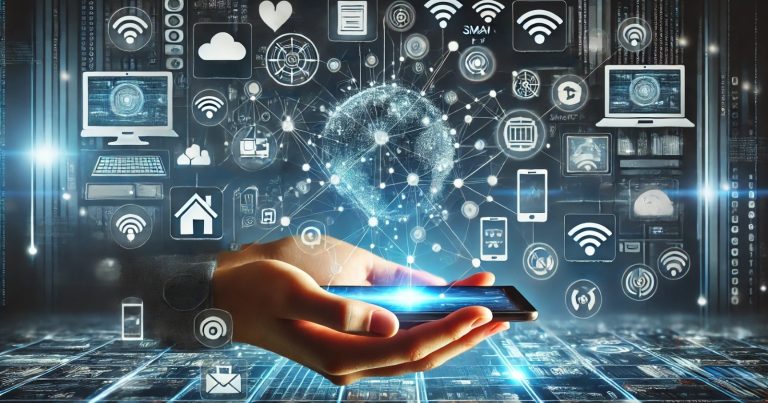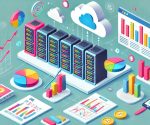Smart technologies are systems, tools, or instruments. These technologies are capable of thinking, learning, and adapting to the situation. Smart homes, smart cars, smart cities and others. Smart Technologies are designed to collect and process data through the integration of sensors, software, and internet connectivity, leading to more informed decision-making processes. From automatically turning on lights to helping cities manage traffic, these tools make lives easier, safer, and smarter. Data Science: The smart technology that enhances our lives
What is Smart Technologies?
Smart technologies, devices, systems, or platforms that automate processes by using sensors, internet connectivity, artificial intelligence, and data analytics to improve efficiency and offer intelligent feedback. These technologies can have user interaction, learn from patterns and make decisions without requiring much intervention from a human.
Smart technology is embedded in devices, systems and places capable of interacting with human and other device activity through advanced technologies. Combining sensors, connectivity and artificial intelligence (AI), these technologies aim to automate tasks, enable and enhance automation, and allow for more efficient workflows.
They are embedded in smart homes, smart cities, wearable devices, and factories. And so there it is, smart tech, which has been changing everyday life, providing us with new opportunities not just to connect, but control. Smart technology: What it is, how it works and where it can improve our lives.
Types of Smart Technologies
Data and several types of smart technologies are used to solve and address very different needs in daily life, industries, education, health, and government, etc. Each of these types plays a distinct role in enhancing efficiency and user experience. Smart technologies of these types have made contemporary living much more energy-efficient, safe, and environmentally friendly.
Smart Home Technology
Smart home products cover a range of devices, including smart lights, smart TVs, thermostats and security systems. Individuals can operate these devices by using their phones or voice assistants such as Alexa or Google Assistant. These smart gadgets help save energy, increase comfort at home, as well as adding an extra layer of security by alerting users of unusual activity or changes.
Smart Healthcare
Wearables such as fitness bands and smartwatches help track heart rate, steps, and sleep patterns in smart healthcare. Smart pillboxes aid patients in taking their medicine on time. AI diagnostic tools to detect diseases at an early stage. These technologies enhance patient care, promote healthy habits and minimize medical threats.
Smart Education
Smart education aims to enhance the process of students learning by integrating technology into the classroom. We use tools like smart boards and interactive screens to make the lessons more engaging. Lessons on online learning platforms are tailored according to students’ performance. Virtual and augmented reality assisted in laying out tough topics in a fun and simple method. These tools aid in better learning outcomes.
Smart Transportation
Smart transportation includes systems that make travelling seamless and safe. GPS apps provide live traffic information and display the ideal routes. Now, electric vehicles and self-driving cars. Many also use mobile applications to check bus or train schedules and arrange ride-sharing services. These tools save time and cut down on pollution.
Smart Cities
Data plays a key part: Smart cities leverage technology and innovation to improve residents’ everyday lives. They have AI-powered traffic lights to ease gridlock and smart streetlights that operate only when necessary. Sensor-based systems that keep track of full bins are also used in some cities to manage waste. These intelligent systems help make cities cleaner, safer, and more efficient.
Smart Agriculture
Smart agriculture, tools that help farmers grow crops better Soil sensors test ground moisture levels. Drones hovering above fields to check on crops’ health. Automated watering systems measure data from the weather station and only water your plants as necessary. These smart tools can conserve water, boost crop yields and reduce farm work.
How Smart Technology Works?
Smart technology is based on integrating hardware with sophisticated software to develop systems and devices that can operate autonomously and adapt based on their usage. Here’s how this technology works and where it might lead:
- Connectivity: The majority of smart devices are Internet-connected and are a part of what is called the Internet of Things (IoT). They are connected because they need to send and receive data to function properly.
- Sensors: Smart devices come with sensors that collect data from their surroundings. A smart thermostat, for example, measures the temperature of a room and then applies heating and cooling accordingly.
- Data Processing: The captured sensor data is processed on the device or sent to a centralized server or cloud for analysis. It processes this data, which allows the device to make informed decisions.
- Machine Learning and AI: A number of smart devices have machine learning algorithms and artificial intelligence that can adapt to data over time. They learn, enabling them to adapt to your habits and improve your functionality. For example, a smart fridge could learn the kinds of groceries you regularly store and suggest recipes based on what’s available at that time.
- Automation and control: After the data is processed and decisions are made, intelligent devices often automatically regulate operations without human involvement. For instance, smart lights can be scheduled to turn on or off, depending on the time of day or the presence of people in the room.
- User Interface: Easy and perform the work with it Smart devices have interface that you can interact with use the services of smart devices. It allows you to control your car through physical buttons, touchscreen panels, mobile apps, or even voice commands.
Real-Life Example
A motion sensor which detects movement in a room can be installed in a smart home. It relays this information to a cloud system, which verifies the time and the light level. If it’s dark, it turns on lights automatically. That’s when the user receives a notification on their phone. This whole process takes just seconds. Real-time decisions are made with the user in mind through the combination of hardware and software working together.
Importance of Smart Technologies
Smart technologies facilitate our lives at high levels where we can do numerous things with very little efforts like setting smart bulbs or ordering food with voice commands or set your home with a voice command. It knows what you want and customises its offering to you personally. It even takes things like traffic or your car’s condition into account to safely guide you. Here are some of its benefits
- Convenience: Devices learn how you use them and can anticipate what you need to do without you doing anything. It’s transforming businesses and simplifying daily life.
- Sustainability: As concerns about the environment grow, smart technology is being used by both companies and homes to reduce energy use. One instance is how it can switch the lights off or change the heating in a room by itself and by doing so saves you a lot of energy and money.
- Security: General improvement in security when compared to old manual systems. Devices such as security cameras and smart locks do more than warn you of potential dangers. They can also take steps to help keep you safe, such as automatically locking a door.
- Optimised Efficiency: Smart devices gather data to determine how to improve. They study patterns to optimise systems, assisting you in avoiding both waking up on the wrong side of the bed and getting to work late.
- Saving Money and Time: Smart devices consume less energy (reducing energy bills) and automate repetitive tasks (giving back time you would otherwise lose).
Relevance to ACCA Syllabus
As such, cutting-edge technologies like AI, IoT and blockchain are taking center stage in the latest Strategic Business Leader (SBL) and Audit and Assurance (AA) papers within the ACCA syllabus. Such technologies enhance financial forecasting, fraud detection, and the quality of auditing that ultimately improves decision-making in financial reporting. After all, in a fast-evolving digital business landscape, ACCA advises accountants of the future to embrace and grasp smart technology to remain relevant.
Smart Technologies ACCA Questions
Q1: Name a smart technology that could potentially be used in the audit space to detect anomalies in real-time transactions?
A) Artificial Intelligence
B) Inventory Tagging
C) Traditional Sampling
D) ERP Systems
Ans: A) Artificial Intelligence
Q2: What makes blockchain good for financial reporting transparency?
A) Sign up for removal of records periodically
B) Through shared, immutable ledgers
C) By limiting system access
D) By hiding data from users
Ans: B) By allowing for shared, immutable ledgers
Q3: What is one of the main advantages of using smart contracts in accounting operations?
A) Manual data verification
B) Terms automatically run when agreed
C) Increasing paperwork
D) Reducing digital records
Ans: (b) Automatic execution of agreed terms.
Q4: Smart technology knowledge is most likely to be tested in which ACCA paper?
A) Taxation
B) Strategic Business Leader
C) Corporate Law
D) Performance Management
Ans: B) Strategic Business Leader
Q5: What smart technology can assist in gathering audit evidence?
A) Cloud Printing
B) Robotic Process Automation (RPA)
C) Spreadsheet Templates
D) Scanned Vouchers
Ans: B) Robotic Process Automation(RPA)
Relevance to US CMA Syllabus
Smart technologies are captured in the US CMA Part 1: Financial Planning, Performance and Analytics digital transformation bucket. CMAs apply IoT for operational analytics, AI for cost forecasting, and RPA for automating reporting tasks. This can help management accountants optimise efficiencies, reduce costs and provide strategic financial insight that fits perfectly with the evolving role of finance professionals.
Smart Technologies CMA Questions
Q1 : What smart technology is used to automate repetitive entries required for accounting?
A) Blockchain
Automation time B) Robotic Process Automation RPA
C) Internet of Things (IoT)
D) VPN
Ans: B) Robotic Process Automation (RPA)
Q2: How is AI being used in financial planning and analysis?
A) Increasing manual errors
B) VUCA or replacing accounting standards
C) Improving the ability to forecast and budget based on data
D) Delaying analysis
Ans: C) Improving data-driven forecasting and budgeting
Q3: Smart sensors communicating with accounting systems via IoT help CMAs by:
(A) Audit notification dispatch
B) Following the use of assets and inventory in real-time
C) Logging into HR systems
D) Sending marketing emails
Ans: B) Real-time inventory and asset usage tracking
Q4: What CMA part covers smart technologies most directly?
A) Part 2
B) Ethics Section
C) 1st Part: Financial Planning & Performance and Analytics
D) Business Law Section
Ans: C) Part 1: Financial Planning, Performance & Analytics
Q5: A smart dashboard used in analytics:
A) Manual Ledger
B) Power BI
C) Windows Media Player
D) Paint
Ans: B) Power BI
Relevance to CFA Syllabus
Smart technologies have significant coverage in the CFA curriculum across Quantitative Methods, Ethics, and Portfolio Management. AI, machine learning, and big data analytics enable more efficient trading, better risk management, and improved investment decision-making. Such fintech revolution does not come as a surprise as it affects financial modeling, compliance and advisory services for clients in a technologically enabled investment environment, and CFA candidates should know how to leverage it.
Smart Technologies CFA Questions
Q1: What is the term used to refer to technology that utilizes algorithms to execute and optimize trading strategies automatically?
A) Artificial Intelligence
B) ERP
C) Manual Processing
D) General Ledger
Ans: A) Artificial Intelligence
Q2: Robo-advisor usually create a personalized investment portfolio based on?
A) Legal opinion
B) AI algorithms
C) Tax codes
D) Human intuition
Ans: B) AI algorithms
Q3: In what way is machine learning helpful in managing portfolio risk?
A) By randomly choosing assets
B) By learning patterns to predict the risk of loss
C) By copying past results
V) By making diversification less effective
Ans: B) By analysing data to predict potential losses
Q4: What smart technology elicits near-real-time accuracy in client reporting and performance dashboards?
A) Digital signature
B) Blockchain
C) Manual spreadsheets
D) Calculator
Ans: B) Blockchain
Q5: Smart technologies are relevant to the work of CFA professionals because:
A) They replace all research
B) ethical substitutes
C) They change the way we analyze, interpret, and use data
D) Eliminate compliance requirements
Ans: C) They change the ways in which data is analyzed, interpreted and used
Relevance to US CPA Syllabus
Smart technologies are in the Audit (AUD) and Business Environment and Concepts (BEC) parts of the US CPA examination. AI in fraud identification, RPA for doing audit testing, and blockchain for secure recordkeeping are some of the tools CPAs leverage. Grasping the mechanics of smart technologies ensures CPAs sustain audit quality, promote financial integrity, and provide real-time insights to clients and regulators.
Smart Technologies CPA Questions
Q1: What smart technology enables CPAs to conduct automated audit testing in a data-rich environment?
A) Robotic Process Automation (RPA)
B) Static IP Systems
C) Accounting Software Only
D) Hard-copy Checklists
Ans: A) Robotic Process Automation (RPA)
Q2: In a CPA audit, how does the blockchain support CPA responsibilities?
A) By hiding records
B) The duplication entries are removed
C) They create records that are time-stamped and tamper-proof
D) By automating HR tasks
Ans: C) Through time-stamped and tamper-proof records
Q3: What is one potential downside to leveraging AI in financial reporting?
A) Lack of internet
B) Reduced performance
C) Biased algorithms or errors based on poorly-trained data
D) Too many staff required
Ans: D) Biased algorithms or bad training data errors
Q4: What CPA exam section includes automation and smart technologies?
A) REG
B) AUD
C) FAR
D) Ethics
Ans: B) AUD
Q5: Smart technologies best serve CPAs in which of the following?
A) Organizing office parties
B) Improve Data Analytics, Fraud Detection, and Compliance
C) Printing invoices
D) Studying accounting textbooks
Ans: B) Improving data analysis, fraud detection and compliance


